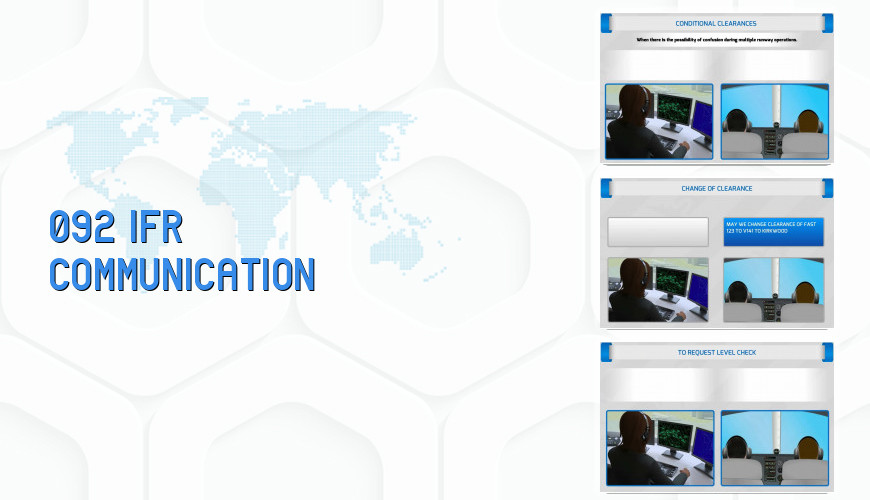
Course Information
Welcome to the IFR communications course. In this course you will be familiarized with the terminology used in aeradio communications. This course also reviews some of the information that was presented in the VFR course. Phraseology in this course will be given in examples. The examples used may state only one option of the following ambiguous statements: ‘left’ or ‘right’, ‘ascend’ or ‘descend’, ‘to’ or ‘from’, ‘magnetic’ or ‘true’, ‘inbound” or ‘outbound’, etc. It should be understood that the either instruction may be given by ATC. As well, some instructions can have many variables i.e. rain, blowing snow, etc. The example will have one word used and the other variables will be listed as appropriate. The callsigns have been removed from the examples in order to reduce redundancy in the course.
Content of the Course
| Slide | 182 | Duration | 1:51:29 | Exam | No |
|---|
- COURSE START
- IFR COMMUNICATIONS
- SECTION 1 / DEFINITIONS
- AIR TRAFFIC SERVICES ABBREVIATIONS
- Q-CODE GROUPS COMMONLY USED IN RTF AIR-GROUND COMMUNICATIONS
- CATEGORIES OF MESSAGES
- SECTION 2 GENERAL OPERATING PROCEDURES / TRANSMISSION OF LETTERS
- Transmission Of Numbers (Including Level Information)
- Transmission Of Time
- Transmission Technique
- STANDARD WORDS AND PHRASES (RELEVANT RTF PHRASEOLOGY INCLUDED)
- Departure Information
- Operational Status Of Visual / Non-Visual Aids
- Rvsm Operations
- Gnss Service Status
- Pushback / Start-Up Procedures
- GROUND CREW / FLIGHT CREW PHRASEOLOGY / STARTING PROCEDURES
- Pushback Procedures
- Towing Procedures
- Taxi Procedures
- Departure
- Backtrack on runway after landing:
- General
- Holding
- To Cross A Runway
- Line-Up / Takeoff Procedures
- Entering Runway Clearance And Waiting For Clearance
- Conditional Clearances
- Confirmation Of A Conditional Clearance
- Take-Off Clearance
- To Cancel A Take-Off Clearance
- Departure Procedures
- Radar Vectors On Departure
- Turn Or Climb Instructions After Take-Off
- Requesting Airborne Time
- Heading Instructions On Take-Off
- For the specific track to be followed:
- Area Control Units
- Level Changes
- Reports
- Rates
- Requests
- Position Information
- Additional Reports
- Level Information
- Joining Airways
- Crossing Airways
- Turbulence Reports
- RADIOTELEPHONY CALL SIGNS FOR AERONAUTICAL STATIONS INCLUDING USE OF ABBREVIATED CALL SIGNS
- AIRCRAFT CALL SIGNS
- Change Of Call Sign
- TRANSFER OF COMMUNICATION
- TEST PROCEDURES INCLUDING READABILITY SCALE; ESTABLISHMENT OF RTF COMMUNICATION
- READ BACK AND ACKNOWLEDGEMENT REQUIREMENTS
- RADAR PROCEDURAL PHRASEOLOGY
- Vectoring For Ils And Other Pilot – Interpreted Aids
- Maneuver During Independent And Dependent Parallel Approaches
- Surveillance Radar Approach
- Elevation
- Par Approach
- Communications
- Azimuth
- Elevation
- Position
- Checks
- Completion Of Approach
- Missed Approach
- Termination Of Radar And/Or Ads-B Service
- Radar And/Or Ads-B Equipment Degradation
- Radar Identification
- Radar Vectoring
- Radar Heading
- Ssr
- General Ats Surveillance Service Phraseology
- Position Information
- Vectoring Instructions
- Termination Of Vectoring
- Maneuvers
- Speed Control
- Position Reporting
- Traffic Avoidance
- To Pass Traffic Information
- Other Secondary Surveillance Radar (Ssr) And Ads-B Phraseology
- To Request The Capability Of The Ads-B Equipment
- To Instruct Setting Of Transponder
- To Request The Pilot To Reselect The Assigned Mode And Code
- To Request Reselection Of Aircraft Identification
- To Request The Pilot To Confirm The Code Selected On The Aircraft’s Transponder
- To Request Temporary Suspension Of Transponder Operation
- To Request Transmission Of Pressure Altitude
- To Request Level Check
- Ads-C Degradation
- Orbit
- Published holding procedure over a facility or fix:
- When a detailed holding clearance is required:
- Conditional Clearances
- LEVEL CHANGES AND REPORTS
- Level Changes, Reports And Rates
- SECTION 3 ACTION REQUIRED TO BE TAKEN IN CASE OF COMMUNICATION FAILURE
- Air To Ground
- Communications Failure In Vmc
- Communications Failure In Imc
- SECTION 4 / DISTRESS AND URGENCY PROCEDURES
- Pan Medical
- DISTRESS (DEFINITION – FREQUENCIES – WATCH OF DISTRESS FREQUENCIES – DISTRESS SIGNAL – DISTRESS MESSAGE)
- URGENCY (DEFINITION – FREQUENCIES – URGENCY SIGNAL – URGENCY MESSAGE)
- SECTION 5 / RELEVANT WEATHER INFORMATION TERMS / AERODROME WEATHER
- Runway Visual Range
- Runway Surface Conditions
- WEATHER BROADCAST
- Atis
- Volmet
- Sigmet
- Airmet
- Reported Conditions By Other Aircraft
- Atc Request For Weather Information
- OTHER CLEARANCES AND COMMUNICATIONS
- 8.33 Khz Channel Spacing
- Maintenance Of Specified Levels
- Specifications Of Cruising Levels
- Emergency Decent
- If Clearance Cannot Be Issued Immediately Upon Request
- Separation Instructions
- Instructions Associated With Flying A Track (Offset) Parallel To The Cleared Route
- Expected Approach Time
- Identification Of Aircraft
- Acknowledgment By Visual Means
- To Request Time Check And/Or Aerodrome Data For Departure
- If Atis Information Is Not Available
- Entering An Aerodrome Traffic Circuit
- Approach Instructions
- Landing Clearance
- Delaying Aircraft
- Missed Approach
- Information To Aircraft
- Runway Vacating And Communications After Landing
- If Possible Jet Blast On Apron Or Taxiway
- Coordination Between Ats Units
- Estimates And Revisions
- Change Of Clearance
- Approval Request
- Handover
- Expedition Of Clearance
- Cpdlc Phraseology
- Low Altitude Warning
- Terrain Alert
- Area Control Services
- Approach Control Services
- Approach Instructions
- SECTION 6 GENERAL PRINCIPLES OF VHF PROPAGATION AND ALCATION OF FREQUENCIES
- Vhf Allocation
- Propagation
- Ground Reflections
- Hf Communication
- Elt
- Radio Interference
- SECTION 7 / MORSE CODE
- Summary
- COURSE END

